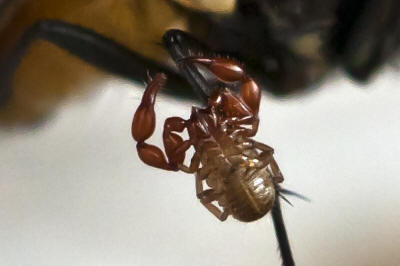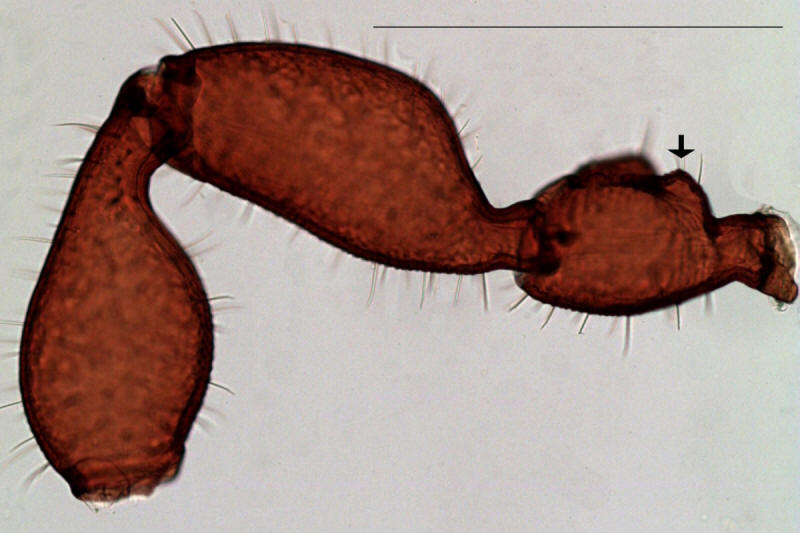Aguiar NO & Bührnheim PF, 1998: Phoretic pseudoscorpions associated with flying insects in Brazilian Amazônia. Journal of Arachnology, 26: 452-459.
Beier M, 1932: Pseudoscorpionidea II. Subord. C. Cheliferinea. Tierreich, 58: i-xxi, 1-294.
Beier M, 1948: Phoresie und Phagophilie bei Pseudoscorpionen. Österreichische Zoologische Zeitschrift, 1: 441-497.
Beier M, 1963: Ordnung Pseudoscorpionidea (Afterskorpione). Bestimmungsbücher zur Bodenfauna Europas. Lieferung 1. Akademie-Verlag, Berlin, 313 pp.
Christophoryová J, 2009: úriky Pseudoscorpiones, pp. 125-135. In: Maán P & Mihál I (eds), Pavúkovce Cerovej vrchoviny (Arachnida: Araneae, Pseudoscorpiones, Opiliones, Acari). tátna ochrana prírody SR Banská Bystrica, Správa CHKO Cerová vrchovina Rimavská Sobota, Ústav zoológie SAV Bratislava, Ústav ekológie lesa SAV Zvolen.
Christophoryová J, 2010: úriky (Pseudoscorpiones) pod kôrou stromov, v dutinách a v hniezdach na Slovensku. Folia faunistica Slovaca, 15(1): 1-12.
Christophoryová J, Krumpálová Z, Kritofík J & Országhová Z, 2011a: Association of pseudoscorpions with different types of bird nests. Biologia, 66/4: 669-677.
Christophoryová J, áhlavský F & Fedor P, 2011b: An updated identification key to the pseudoscorpions (Arachnida: Pseudoscorpiones) of the Czech Republic and Slovakia. Zootaxa, 2876: 35-48.
Christophoryová J, áhlavský F, Krumpál M & Fedor P, 2011c: Pseudoscorpions of the Czech Republic and Slovakia: An annotated and revised checklist (Arachnida: Pseudoscorpiones). North-Western Journal of Zoology, (in press).
Drogla R & Lippold K, 2004: Zur Kenntnis der Pseudoskorpion-Fauna von Ostdeutschland (Arachnida, Pseudoscorpiones). Arachnologische Mitteilungen, 27/28: 1-54.
Ducháè V, 1993: Zwei neue AfterskorpionArten aus der Tschechischen Republik. Arachnologische Mitteilungen, 5: 36-38.
Gardini G, 2000: Catalogo degli Pseudoscorpioni dItalia (Arachnida). Fragmenta Entomologica, 32: 1-181.
Harvey MS, 2009: Pseudoscorpions of the World. Version 1.2. Western Australian Museum, Perth. Internet: http://www.museum.wa.gov.au/research/databases/pseudoscorpions (accessed 12 October 2011).
Helversen O. von, 1966: Pseudoskorpione aus dem Rhein-Main-Gebiet. Senckenbergiana biologica, 47: 131-150.
Jêdryczkowski WB, 1987: Zaleszczotki (Pseudoscorpiones) Bieszczadów. Fragmenta Faunistica Musei Zoologici Polonici, 30: 341-349.
Kaisila J, 1949: A revision of the pseudoscorpion fauna of eastern Fennoscandia. Annales Entomologici Fennici, 15: 72-92.
Krumpál M, Christophoryová J, 2007: úriky (Pseudoscorpiones) PR Ostrov Kopáè, pp. 95-100. In: Majzlan O. (ed.), Príroda ostrova Kopáè. Fytoterapia OZ, Bratislava.
Krumpál M & Cyprich D, 1988: O výskyte úrikov (Pseudoscorpiones) v hniezdach vtákov (Aves) v podmienkach Slovenska. Zborník Slovenského národného múzea, Prírodné vedy, 34: 41-48.
Krumpál M, Krumpálová Z & Cyprich D, 1997: Bezstavovce (Evertebrata) skleníkov Bratislavy (Slovensko). Entomofauna carpathica, 9: 102-106.
Legg G & Jones RE, 1988: Pseudoscorpions (Arthropoda; Arachnida). Keys and notes for the identification of the species, pp. 1-159. In: Kermack DM & Barnes RSK (eds), Synopses of the British Fauna (New Series), No. 40. The Linnean Society of London and the Estuarine and Brackish-Water Sciences Association, Leiden New York København Köln.
Lohmander H, 1939a: Zur Kenntnis der Pseudoskorpionfauna Schwedens. Entomologisk Tidskrift, 60: 279-323.
Lohmander H, 1939b: Zwei neue Chernetiden der nordwesteuropäischen Fauna. Göteborgs Kungliga Vetenskaps- och Vitterhetssamhälles Handlingar, 6(11): 1-11.
Maán P & Kritofík J, 1992: Phoresy of some arachnids (Acarina and Pseudoscorpionidea) on synanthropic flies (Diptera) in the south Slovakia. Biologia, 47(2): 87-96.
Meinertz T, 1964: Beiträge zur Verbreitung der Pseudoskorpioniden in Dänemark. Videnskabelige Meddelelser fra Dansk Naturhistorisk Forening i Kjøbenhavn, 126: 387-402.
Mináø J, 1966: Phoresia of Damalinia (C.) meyeri (Mallophaga) and Lamprochernes nodosus (Pseudoscorpionidea) on mosquitoes Aëdes sticticus (Culicidae). Folia Parasitologica, 13: 270-273.
Palmgren P, 1973: Über die Biotopverteilung waldbodenlebender Pseudoscorpionidea (Arachnoidea) in Finnland und Österreich. Commentationes Biologicae, 61: 1-11.
Petrov BP, 2004: The false scorpions (Arachnida: Pseudoscorpiones) of the Eastern Rhodopes (Bulgaria and Greece), pp. 153-166. In: Beron P & Popov A (eds), Biodiversity of Bulgaria. 2. Biodiversity of Eastern Rhodopes (Bulgaria and Greece). Pensoft and National Museum of Natural History, Sofia.
Poinar GO Jr, Æurèiæ BPM & Cokendolpher JC, 1998: Arthropod phoresy involving pseudoscorpions in the past and present. Acta Arachnologica, 47: 79-96.
Rafalski J, 1967: Zaleszczotki. Pseudoscorpionidea. In: Katalog Fauny Polski, vol. 32(1): 1-34. Polska Akademia Nauk, Warszawa.
Ressl F & Beier M, 1958: Zur Ökologie, Biologie und Phänologie der heimischen Pseudoskorpione. Zoologische Jahrbücher, Abteilung für Systematik, Ökologie und Geographie der Tiere, 86: 1-26.
Tömösváry O, 1882: Pseudoscorpiones Faunae Hungaricae. A Magyar fauna álskorpiói. Magyar Tudományos Akadémia Matematikai és Természettudományi Közlemények, 18: 135-256.
Vachon M, 1954: Nouvelles captures de Pseudoscorpions (Arachnides) transportés par des insectes. Bulletin du Muséum National dHistoire Naturelle, Paris, 26: 590-592.

